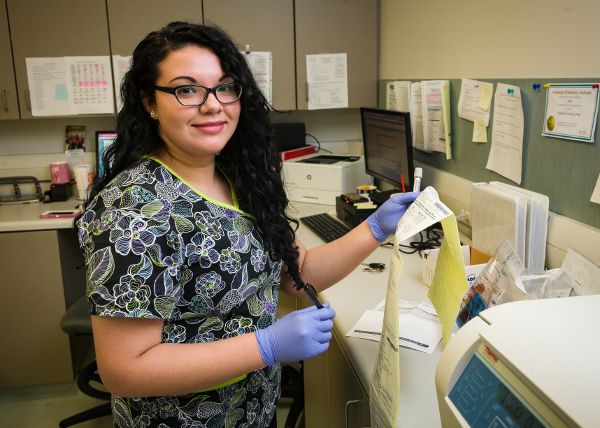Overview
Testicular cancer begins when cells in the testicles start to grow uncontrollably. A tumor can form when more cancer cells develop, and it can spread to other areas of the body. As it grows and spreads, the cancer becomes more advanced.
The testicles are male reproductive organs located in the scrotum, which produce sperm and androgens (male hormones) like testosterone.
Types of testicular cancer include:
- Germ cell tumors (Over 90% of testicular cancers are of this type)
- Seminomas
- Classical seminoma
- Spermatocytic seminoma
- Non-seminomas and mixed germ cell tumors
- Embryonal carcinoma
- Yolk sac carcinoma
- Choriocarcinoma
- Teratoma
- Seminomas
- Carcinoma in situ or intratubular germ cell neoplasia
- Stromal tumors
- Leydig cell tumor
- Sertoli cell tumor
Cancers may also spread to the testicles and form a secondary testicular cancer. This is most common in lymphoma and can also occur in cases of leukemia, prostate cancer, lung cancer, melanoma, kidney cancer, and others.
Symptoms
Often testicular cancer causes a lump or swelling in the testicle. It is important to note that lumps in the testicle can be caused by a number of other non-cancerous causes, but it is important to be checked by a medical professional with this symptom.
Other symptoms of testicular cancer may include:
- Pain, heaviness, or aching in the abdomen or scrotum
- Breast growth or soreness
- Signs of early puberty like deepening voice or facial hair growth
Advanced testicular cancer or the spread of testicular cancer may cause:
- Lower back pain
- Shortness of breath, chest pain, or cough
- Abdominal pain
- Headaches or confusion
Risk Factors
An undescended testicle, a condition also known as cryptorchidism, is one of the main risk factors for testicular cancer. Surgery to correct cryptorchidism may reduce the risk of the cancer, particularly if it is completed when the patient is young.
Pre-existing conditions including Kleinfelter’s syndrome, HIV infection (and especially AIDS), and a prior or family history of testicular cancer are associated with a higher risk of this cancer. (However, most cases of testicular cancer are not associated with a family history of the disease.)
White men’s risk of testicular cancer is 4 to 5 times higher than that of black and Asian-American men. Some studies have found a higher risk of testicular cancer in tall men. While testicular cancer can affect men at any age, about half of all cases occur in patients aged 20 to 34.
Testicular injury, strenuous physical exertion, and activities like horseback riding are popularly thought to be associated with an increased risk of testicular cancer, but there is no research to support the idea that any of these would increase a man’s likelihood of developing testicular cancer in the future.
Prevention
Most diagnoses of testicular cancer are not associated with a known risk factor or behavior, and most known risk factors are not modifiable (age, race, prior conditions, etc. cannot be changed), so it is not possible to prevent most cases.
Correcting an undescended testicle is recommended, but it is not known how much this procedure decreases testicular cancer risk.
Diagnosis
While some testicular cancers are found after a lump or other symptoms appear, many men are diagnosed with no symptoms at all. For this reason, regular screenings are important for early detection, and testicular examination is recommended as part of a regular physical examination by your family doctor.
Regular testicular self-exams may be beneficial, particularly for men with known risk factors for developing testicular cancer, but there is no official recommendation at this time, and it is not yet known how self-exams affect cancer outcomes. For instructions on how to perform a testicular self-exam, visit the American Cancer Society website.
If testicular cancer is suspected, a doctor will perform a physical examination including close inspection of the testicles, abdomen, and other areas of the body. Imaging, especially ultrasound, may be used to determine whether a lump is likely to be cancer, and blood tests may be ordered to look for certain markers associated with testicular cancer.
A surgical biopsy is often used to confirm the diagnosis of other types of cancer, but in suspected cases of testicular cancer, doctors will usually recommend complete removal of the tumor rather than biopsy. In rare cases, biopsy may be recommended instead.
Other imaging tests may be used to examine whether and how testicular cancer may have spread, including: X-ray, CT, MRI, PET, and bone scan.
Treatment
The treatment plan will depend on the stage of the cancer, as well as other factors. Our doctors will work closely with you and your family determine the best treatment plan for you. Options for treatment could include:
- Surgery
- Radiation therapy
- Chemotherapy
- High-dose chemotherapy and stem cell transplant
Your doctor may decide more than one of these treatment options will be in your best interest. Surgery is the most common treatment option.







